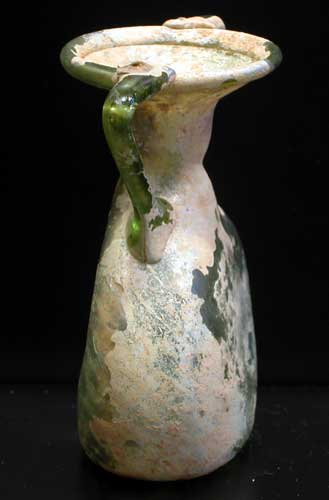Small Glass Lenticular Flask, 300 CE - 400 CE
Free-Blown Glass
3.5 x 4
LO.942
Further images
The greenish glass flask with lenticular body, short neck and thick tubular rim folded inward, with no base, traces of tooling and pontil mark. Two handles in darker green colour...
The greenish glass flask with lenticular body, short neck and thick tubular rim folded inward, with no base, traces of tooling and pontil mark. Two handles in darker green colour rising from the shoulder and attached above the rim, each with a projection folded outward. Heavy weathering crust and iridescence throughout.
The shape of these vessels, already found in ceramic prototypes of the 2nd millennium BC, was especially easy to produce in blown glass, since it could be simply achieved by flattening a globular bubble. These plain flasks usually lack bases and handles and they were probably provided with special carrying cases of leather, straw or cloth to protect them during transport and which could be tied with handles so that the flask could be suspended.
The lenticular flasks were used to hold liquids, but the miniature ones, such as this one, were used for perfumes and costly oils; indeed an excavated example from Apamea, Syria, yielded traces of holy oil in it. In the 3rd and 4th centuries, lenticular flasks acquired handles and sometimes even bases.
For a comparable example see: Y. Israel, Ancient Glass in the Israel Museum, 2003: pl. 358, p. 269.
The shape of these vessels, already found in ceramic prototypes of the 2nd millennium BC, was especially easy to produce in blown glass, since it could be simply achieved by flattening a globular bubble. These plain flasks usually lack bases and handles and they were probably provided with special carrying cases of leather, straw or cloth to protect them during transport and which could be tied with handles so that the flask could be suspended.
The lenticular flasks were used to hold liquids, but the miniature ones, such as this one, were used for perfumes and costly oils; indeed an excavated example from Apamea, Syria, yielded traces of holy oil in it. In the 3rd and 4th centuries, lenticular flasks acquired handles and sometimes even bases.
For a comparable example see: Y. Israel, Ancient Glass in the Israel Museum, 2003: pl. 358, p. 269.







